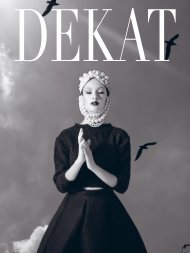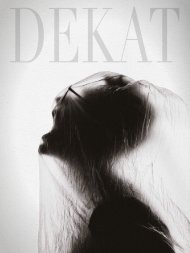1
You also want an ePaper? Increase the reach of your titles
YUMPU automatically turns print PDFs into web optimized ePapers that Google loves.
WILLIAM BLAKE<br />
Three pieces in the yard were inspired by the work of William Blake. Two cement sculptures, a chrysalis baby on an oak leaf and a prophetess resembling a shepherd, are renditions<br />
of illustrations from Blake’s For the Sexes: The Gates of Paradise. A third sculpture is of Adam and Eve and is taken from Blake’s illustration The Temptation and Fall of Eve in an edition<br />
of John Milton’s Paradise Lost. Helen also wrote out the caption accompanying the chrysalis baby on a column above the sculpture, which reads:<br />
What is Man!<br />
The Suns Light when he unfolds it<br />
Depends on the Organ that beholds it<br />
Blake, who was born in London in 1757 and died in 1827, was a visionary printmaker, artist and poet who mixed images and text to complement each other. The engravings that<br />
accompanied his poetry were more than illustrations – the one could not exist without the other. In his life, the imagination ruled supreme and was a divine gift. In some ways, he<br />
resembles an outsider artist as his work was never truly appreciated or understood in his lifetime, only becoming canonical thanks to the advocacy of the Romantic poets of the<br />
next generation. Prophetically, he stated that his work would only truly be recognised in later ages.<br />
Blake had an exceptionally visual mind and saw figures of his imagination as if they were flesh and blood. He identified four kinds of vision he experienced, the higher forms of which<br />
were almost supernatural. The first type was what he called single vision – that which encompasses only the material world, the world of science and rationality. What he called<br />
two-fold vision was the realm of subjectivity and imagination. Three-fold vision was when he entered a domain he called Beulah, the realm of the subconscious. Blake described it<br />
as: “There is a place where Contrarieties are equally true. This place is called Beulah. It is a pleasant lovely Shadow, where no dispute can come, because of those who sleep.” The<br />
highest vision, experienced only rarely, was four-fold. This was the territory where the characters of his own mythological world resided. Here you could find figures such as Urizen<br />
and Albion, visions of time and space and characters from works such as Paradise Lost, the Bible and Dante’s Divine Comedy.<br />
It’s interesting that Helen was drawn to Blake’s work as there were notable similarities between their experiences of the world. Blake, in many ways a misfit, found refuge in a world<br />
crafted from his imagination and artistic creation. It could be argued that in many ways Helen’s conception of the East resembled Blake’s realm of Beulah – taking the form of a<br />
fairytale world that offered release from an often difficult existence. Although she was not able to create art with her own hands, she clearly had a very rich imagination and made<br />
use of everything from books to postcards to share her vision with collaborators such as Van der Merwe and Malgas.<br />
198 FOR THE LOVE OF LIGHT<br />
FOR THE LOVE OF LIGHT 199





